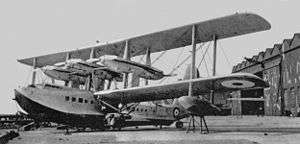Short Sarafand
| S.14 Sarafand | |
|---|---|
 | |
| The prototype and only Sarafand at Felixstowe in 1932. | |
| Role | Flying boat |
| Manufacturer | Short Brothers |
| First flight | 30 June 1932 |
| Retired | 1936 |
| Status | Prototype |
| Primary user | Royal Air Force |
| Number built | 1 |
| Developed from | Short Singapore |
The Short S.14 Sarafand was a British biplane flying boat built by Short Brothers. It was planned as a general reconnaissance aircraft for military service. When it was built in 1932 it was the largest aeroplane in the United Kingdom.
The Sarafand was first proposed by Oswald Short in 1928 as an enlarged development of the Singapore II, to provide transatlantic range capabilitity. Short managed to persuade first his chief designer Arthur Gouge and then the Chief of the Air Staff, Sir Hugh Trenchard (later Viscount Trenchard) of the feasibility of such a large aircraft and Air Ministry specification R.6/28 was drawn up to define the project. It was conducted as a public/private joint venture, the Air Ministry funding it with £60,000 and Short Brothers providing the rest.[1] The aircraft was originally designated the Short R6/28 before being named the Sarafand.[2]
Design
The Sarafand was a six-engined biplane flying boat with equal span wings.[2] Due to the high wing end loads, Gouge specified corrugated steel spars for both upper and lower wings. The six engines, in tractor/pusher pairs, were housed in monocoque nacelles mounted between the wings on integral girders;[2] the central nacelle was further supported by two pairs of splayed struts to the lower wing-roots. The hull, largely constructed of anodised Alclad, had a stainless-steel planing bottom.[3] It had a monoplane tail unit with one large fin and two small auxiliary fins on the tailplane.[2]
Operational history
The maiden flight, with Shorts' Chief Test Pilot, John Lankester Parker at the controls and Oswald Short as co-pilot, was made at Rochester on the River Medway on 30 June 1932.[4] Only one S.14 was built (serial S1589) and it was later used for experimental flying at the Marine Aircraft Experimental Establishment at Felixstowe.[2] The Sarafand was scrapped there in 1936.
Operators
Specifications
Data from The Short "Sarafand" [5]
General characteristics
- Crew: 9 (2 pilots, navigator, radio operator, engineer, four gunners)
- Length: 89 ft 5 in (27.26 m)
- Wingspan: 120 ft 0 in (36.59 m)
- Height: 30 ft 4 in (9.25 m)
- Wing area: 3,460 sq ft (322 m²)
- Empty weight: 44,753 lb (20,342 kg)
- Loaded weight: 70,000 lb (31,820 kg)
- Powerplant: 6 × Rolls-Royce Buzzard in three tractor/pusher pairs, 825 hp (615 kW) each
Performance
- Maximum speed: 150 mph (130 knots, 246 km/h)
- Range: 1,450 miles (1,261 NM, 2,335 km)
- Service ceiling: 13,000 ft (3,960 m)
- Rate of climb: 750 ft/min (3.8 m/s)
Armament
- Guns: Four 0.303 in Lewis machine guns mounted on Scarff rings; provision was made for a 1½-pounder (37 mm) gun to be fitted in the bow.[6]
See also
Related development
Aircraft of comparable role, configuration and era
References
- "The Short "Sarafand"". Flight. 13 June 1935. pp. 631–634.
- Barnes, C.H.; James D.N. (1989). Shorts Aircraft since 1900. London: Putnam. ISBN 0-85177-819-4.
External links
| Wikimedia Commons has media related to Short Sarafand. |